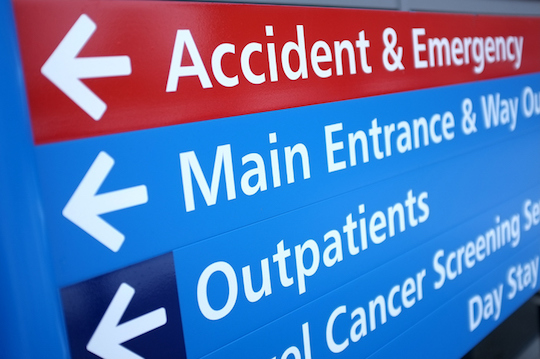We need more staff, more acute hospital beds, and more space and facilities in social care
 Without spending this Christmas and New Year in a remote igloo in Lapland, it would be almost impossible to be unaware of the long queues of ambulances waiting outside NHS A&E departments, the patients on trolleys in those departments waiting for beds, or the patients on wards awaiting care in the community. But these are the daily facts of acute medical care in the sixth richest country in the world; an inevitable crisis due to “unprecedented and unexpected levels of demand” every winter we are told—except that last summer was the worst “winter” on record for the NHS. And unlike an earthquake or a flood, the coming of winter is entirely predictable.
Without spending this Christmas and New Year in a remote igloo in Lapland, it would be almost impossible to be unaware of the long queues of ambulances waiting outside NHS A&E departments, the patients on trolleys in those departments waiting for beds, or the patients on wards awaiting care in the community. But these are the daily facts of acute medical care in the sixth richest country in the world; an inevitable crisis due to “unprecedented and unexpected levels of demand” every winter we are told—except that last summer was the worst “winter” on record for the NHS. And unlike an earthquake or a flood, the coming of winter is entirely predictable.
The NHS has always struggled to meet demand. In 1949, Aneurin Bevan, its chief instigator, talking about his creation after its first year, said: “One of the chief causes of our troubles is the increasing demand made on our hospitals by the aged sick.” And he was as right then as he would be today. The population of the UK has grown by around 10% in a decade and there are more people over 85 years old than ever before—over 200 more every single day, in fact. Through no fault of their own, these older citizens attend A&E departments twice as often as people in their 30s, have a much greater chance of being admitted to hospital, and cost the NHS over five times as much as a younger person. But although people are living longer, much of that extra time is spent in poor health and an estimated one in eight elderly people are not receiving the social support that they need. Meanwhile, the expanding population requires proportionately more electricity, more water, more school places and quite obviously—more healthcare.
In 2016, there was an average of 2,210 more attendances at major A&Es every day compared with 2015—a 5.5% increase—while emergency admissions to hospital have increased by 20% in the last five years. Nevertheless, with an uncanny lack of predictive ability, our responsible agencies have left us short of both staff and capacity in hospitals, community, and social care. The NHS actually has fewer hospitals and fewer beds than almost any other developed nation—and another 15,000 beds have been lost in the last six years. But with over 5% of these precious beds being occupied by patients awaiting care in the community—where the number of beds has reduced by 4,000 in the last two years—bed occupancy levels (reported at midnight!) are now sometimes at 100% in busy hospitals. Consequently, the number of people waiting on A&E trolleys for a ward bed for 12 hours or longer doubled in 2016 when compared with 2015. To increase hospital capacity, the NHS cancelled planned operations in their thousands as winter approached. But many of the people awaiting surgery have ongoing symptoms and so present at their local A&E department seeking help.
Staff vacancies in the NHS have increased by 16% in the last two years. The gaps are caused by doctors and nurses leaving training posts, changing specialty, emigrating, retiring, and finding other sources of income—a tragedy for professional jobs that are both enormously interesting and worthwhile. As a result, every single day, hospitals spend £1.5 million on temporary medical and nursing staff for their A&E departments.
The government of the day usually gets the blame for this situation. However, with a blatant disregard of the evidence that would make even the President of the Flat Earth Society blush, “experts” from the healthcare professions, management and health economics have queued up to reassure successive governments that the NHS does in fact have enough capacity—it just needs to be “smarter”, more efficient, and to improve “flow.” Consequently, we have employed an army of management consultants, improvement specialists, and quality inspectors to try to solve the conundrum of how to get a quart into a pint pot without actually spending the time and money required to address the root cause of the problem. Meanwhile, the inspectors themselves squeeze past old ladies waiting for hours on hard trolleys in order to deal with the pressing issue of a badly positioned sink in the A&E sluice. Of course, I am deliberately failing to recognise the important improvement work that continues to advance patient care throughout the NHS on a daily basis but, for most patients, the long waits in uncomfortable conditions with limited privacy, outweigh the beneficial changes that are undoubtedly occurring.
My conclusion is simple. If we want to avoid yet another winter of the same depressing headlines about A&E departments—and it is far too late to avert the imminent problems for this year—then our services need more capacity to care for our rapidly growing and ageing population. This requires more staff, more acute hospital beds and more space and facilities in social care. We will need to pay for the health service that we all want—or else we may have to make do in our old age with the health service that we currently pay for.
Chris Moulton is the vice president, Royal College of Emergency Medicine, and consultant in emergency medicine at Royal Bolton Hospital.
Competing interests: None declared.
